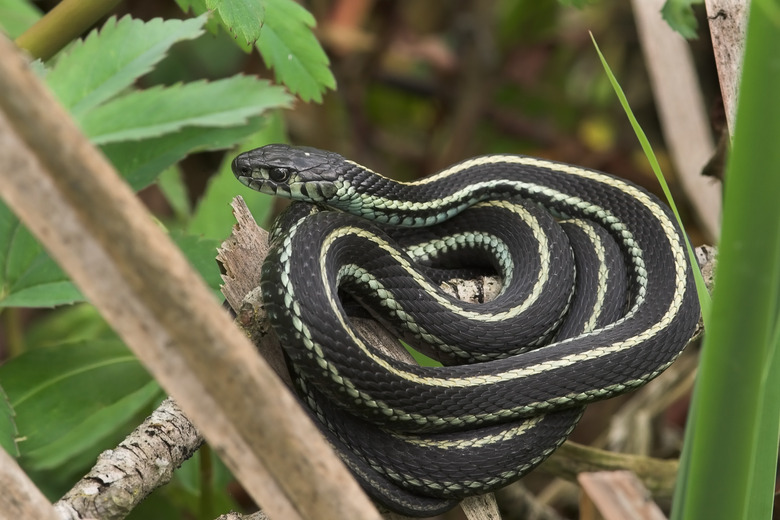Difference Between A Garter & Garden Snake
The garter snakes (Thamnophis) belong to the collective category of harmless, effectively non-venomous North American snakes also often referred to as garden snakes. Many species and subspecies range across much of the continent. The "garden snake" moniker stems from how frequently garter snakes are found in gardens and yards, where they prosper amid moist soil conditions and rich food sources. Although many people irrationally fear garter snakes, they are actually beneficial in controlling garden pest populations such as slugs.
TL;DR (Too Long; Didn't Read)
Many people call garter snakes – some of the most common, widespread and frequently observed snakes in North America – "garden snakes," a reflection of their common occurrence in yards and farm plots. In other words, a garter snake and a garden snake are one and the same.
Garter Snake Description & Range
Garter Snake Description & Range
Most garter snakes boast bold coloration, lateral stripes and checkered patterns, making them fairly easy to spot. The underside or belly tends to be a pale yellow or white with no stripes on both males and females. Garter snakes are normally between 18 and 26 inches long with males being a bit thicker and longer than females, but they can reach lengths of up to 4 feet. Garter snakes range throughout much of North America, from central Canada south through Mexico; in the Lower 48, they're only absent from portions of the Southwest.
Habitat and Diet
Habitat and Diet
Garter snakes can swim but are not agile climbers; they inhabit meadows, marshes, ditches and damp woods, staying close to the ground looking for insects, frogs, salamanders, fish and tadpoles. They'll also occasionally eat bird eggs, mice, leeches and small carrion – not to mention smaller snakes, such as the ring-necked. Farms, forest edges and roads make common hunting grounds for garter snakes.
Predators of the Garter Snake
Predators of the Garter Snake
Many predators eat garter snakes, including larger relatives such as the black rat snake and northern water snake. Raccoons, opossums, skunks, snapping turtles, large bullfrogs and various birds of prey are other common hunters of garter snakes. These snakes also frequently meet their end on roadways, and, unfortunately, are often killed by human beings unaware of the many benefits they provide.
Interesting Facts
Interesting Facts
Garter snakes are one of the first snakes to appear in spring and can be active throughout the year, even on warm winter days. Unlike other snakes, garter snakes do not lay eggs; instead, they give live birth to as many as 50 babies at once.
Cite This Article
MLA
Adkins, Falinia. "Difference Between A Garter & Garden Snake" sciencing.com, https://www.sciencing.com/difference-between-garter-garden-snake-8534124/. 4 May 2018.
APA
Adkins, Falinia. (2018, May 4). Difference Between A Garter & Garden Snake. sciencing.com. Retrieved from https://www.sciencing.com/difference-between-garter-garden-snake-8534124/
Chicago
Adkins, Falinia. Difference Between A Garter & Garden Snake last modified March 24, 2022. https://www.sciencing.com/difference-between-garter-garden-snake-8534124/
